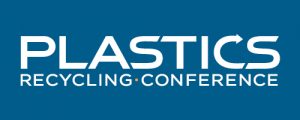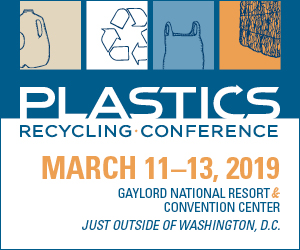In September of this year, the global management consultancy McKinsey & Company published a report showing that of all the plastic waste generated worldwide, only 16 percent is collected for mechanical recycling. When researchers factored in the amount lost in processing, they determined only 12 percent of generation is actually reprocessed.
Clearly, the wider plastics industry needs a plan for improvement. While there is plenty of room for bolstering the current plastics recycling infrastructure, it may be wise to also take a deep look at how the plastic stream is changing and then chart a path forward based on big-picture trends and market realities.

Nina Goodrich
First, we must recognize plastic production and use are continuing to increase. At the same time, many brands have pledged to make their packaging recyclable by 2025 and increase the use of recycled content. And those types of commitments have the power to drive real growth in our sector. Unfortunately, our current collection and sorting systems sending resins for mechanical recycling will not be able to supply the quality required for a massive increase in recycled content use.
Our system is currently out of balance. But in coming to terms with that fact, we open up an opportunity to create new approaches and design for the future.
Living in a flexible world
As an example of how and why we must reconfigure larger approaches to plastics recovery, we can look at what is developing around flexible film packaging.
Flexible packaging is typically not recoverable using the current recycling infrastructure in North America, but a number of factors are pointing to its ongoing growth in usage among brand owners.
For instance, it is clear that as food science processing technology expands, food companies will have opportunities to leverage flexible packaging in new ways. We can already see this in the rapid transition of baby food to flexible pouches. New food processing technologies such as microwave assisted thermal processing (MAT) and high pressure processing (HPP) will continue to drive more packaging conversions.
MAT processing is an alternative to traditional thermal processing. In this system, the food is put in a flexible pouch, sealed and then processed with microwaves in a water bath. Using a frequency that is much lower than that used in a household microwave, the processing eliminates microorganisms in a very short period of time, increasing the flavor and texture of the food product. It can be used to create shelf-stable foods or used to lengthen the shelf life of refrigerated foods.
HPP also requires the use of a flexible or semi-rigid package. The product is sealed inside, and the container is placed in a high-pressure vessel to decrease microorganisms. It is typically used with heat-sensitive foods like juices and smoothies, but the process has a wide range of other applications.
Those types of packaging benefits complement the sustainability-oriented upsides of flexible packaging that have been discussed among stakeholders for some time – for instance, the use of flexible packaging can, in some instances, reduce overall materials usage or boost transport efficiency in comparison to other packaging types.
The flexible packaging example underlines the fact that to enable circularity, we need to predict the material mix of the future and develop our infrastructure to meet future needs.
Getting a grasp on characteristics of different resins
At the same time, it’s critical to understand how plastics are made and what is important for their continued performance in new cycles.
It is time we recognized that all plastics are not the same. Some are easier to recycle than others, and all plastics have a limited number of mechanical cycles.
In many ways, plastics are not so different from paper, where the fibers get shorter each time they are recycled. Polypropylene and polyethylene, for instance, have very long polymer chain lengths. These will only get shorter with exposure to the environment and heat from processing and reprocessing. They can’t be repaired. The shorter they get, the more they lose their performance properties.
For a PE or PP polymer to perform, it needs to have approximately 10,000 polymerization units. Contrast this with PET, which is a polycondensation polymer, meaning it can be repaired. The PET chain length, usually between 150 and 200 polymerization units long, can be increased in a reversible reaction. This allows recycled PET to theoretically meet the same performance requirements as virgin PET resin. The reason it has a practical limit is because of additives that are used to enhance performance and yellowing that comes from repeated heat processing histories.
Learn more in person
Chemical recycling and other emerging plastics recovery strategies receiving investment will be the topic of the opening plenary session at the 2019 Plastics Recycling Conference. The Plastics Recycling Conference is taking place March 11-13 at the Gaylord National near Washington, D.C. Go to the conference website to learn more and register.
On the other hand, PE starts with ethylene, a very inexpensive material. It takes tremendous heat and pressure to create chains that are 10,000 units long. Think of PE as spaghetti and PET as macaroni. It is difficult and expensive today to break PE back down into ethylene, but it can be broken down economically into some other building blocks of products such as industrial waxes and diesel fuel. We call this chemical recycling.
Newer companies, including Renewlogy and RES Polyflow, are focused on making these chemical intermediates from PE and PP.
In addition, other emerging operations are working to help us break through the current limits on PET recovery. Loop Industries in Canada has developed and commercialized a process to depolymerize PET using a system that does not require heat or water, thus limiting the environmental footprint. New PET can be made from the terephthalic acid and ethylene glycol derived from the Loop process, providing virgin performance from recycled building blocks. The depolymerization process can also remove color and additives.
Take a broad view
Technologies in line with what has been discussed above can be used to create other chemical building blocks, but not all processes may be economically viable or have readily available markets at this point.
Right now, the best move for the industry would be to explore all of these technologies. There isn’t one best solution today, but when we broaden our options, new possibilities emerge. This is especially true because we are striving to recover materials, like flexible packaging, that are themselves evolving.
We will need to build both our mechanical recycling capacity and embrace new chemical recycling technologies if we are truly going to create value from our recovered materials.
This approach will require a bit of a mindset shift from the industry, but a shift is just what we need. As the numbers at the beginning of this story demonstrate, under the current system, we are not making much progress toward developing next lives for our plastic waste.
Nina Goodrich is director of the Sustainable Packaging Coalition and executive director of GreenBlue and can be contacted at [email protected].




